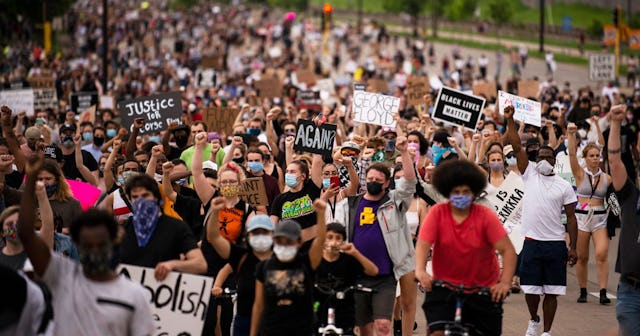AOC Shares Tips For Protesting––This Is Info We All Need To Have And Share

In cities across the United States, and the world, protesters have taken to the streets to demand justice for George Floyd, a black man who was killed by a Minneapolis police officer. In the aftermath of his death, activists have come together to speak out against a system that consistently overlooks and forgives the unjust killing of members of the black community.
The protests are largely peaceful, but many have been disrupted by violence—police officers using tear gas and rubber bullets on crowds—and all are occurring against the backdrop of a deadly virus that has already taken more than 100,000 American lives.
With that in mind, activists and social organizations are sharing what you need to know in order to protest safely and effectively, and the ways you can stay safe and healthy as you speak out.
What You Should Wear And Bring:
People sit on the street in front of a row of police officers during a rally in Minneapolis, Minnesota, on May 29, 2020 after the death of George Floyd, a black man who died after a white policeman kneeled on his neck for several minutes. Kerem Yucel/Getty
Wear a mask, goggles, comfortable running shoes, and layers of colors—all solid color and nondescript that will cover any identifying tattoos.
Bring water, snacks, cash, ID and emergency contact information. Also bring a first aid kit, which includes hand sanitizer, Wet Wipes, and tissues, and a change of clothes in a plastic bag. In case of arrest, be prepared with several days worth of prescription medication and menstrual pads. (Amnesty International suggests avoiding use of tampons, as there may be no chance to change.)
Don’t forget protest signs. Find your message. Add your voice. Images are as impactful as the spoken word.
What You Should NOT Bring:
Technology is tricky. You want your phone to be able to document everything you see; however be sure to turn off Face/Touch ID, go on airplane mode, and disable data. Use apps like Signal or What’s App, which are encrypted, to communicate. All of this is to keep your phone from becoming a “large record of who you are, what you’re up to, and where you’ve been,” to which authorities may have access.
Don’t wear contact lenses. In the case of exposure to teargas, the chemicals can get trapped behind the lenses and you (or someone with clean hands) will have to remove the contacts.
Don’t wear jewelry or anything you don’t want to be arrested with, particularly anything that can be used to add or exacerbate charges.
What You Need To Know Before You Go:
Protesters gather in Harlem to protest the recent death of George Floyd on May 30, 2020 in New York City. David ‘Dee’ Delgado/Getty
A few of the most important points being shared across social media platforms have nothing to do with what you’re wearing or not wearing, or what you’re carrying or not carrying.
Know your rights. Under Freedom of Expression and Assembly, and the Protection of the Right to Freedom of Assembly, the right to assemble and express your opinion is protected, and law enforcement is not permitted to restrict that peaceful public assembly. Freedom from excessive use of police force means you have the freedom to protest non-violently without fear of excessive police force. If you are injured, the right to medical assistance ensures you receive that medical attention without delay. Freedom from Arbitrary Arrest and Detention grants you the right to be told the reason for your arrest and to be given access to a lawyer. If any of those rights have been violated, the right to complain guarantees you have the right to file a complaint.
Be aware of COVID-19 guidelines. Social distance, if and when it’s possible. Loud talking and yelling expel more respiratory droplets, which could spread infection. Assess your risk—determine whether you live with anyone who is in the high-risk category, who you wouldn’t want to expose, or if you yourself might be high-risk. If you’re feeling ill, stay home — there’s so much you can do to help from there. Share information, donate funds to activists and bail funds to help jailed protestors, contact representatives, educate yourself, and talk to your kids.
Representative Alexandria Ocasio-Cortez shared these four pieces of advice for protestors on her Instagram page. She urged activists to:
- Look out for things that don’t seem right: Across social media, stories are emerging of white supremacists potentially creating chaos—breaking windows and destroying property—during otherwise peaceful protests, to either distract from the message or turn the tide of support. There’s power in information and records. Be prepared to film or write down what you see—both with respect to infiltration attempts and police actions.
- Follow the directions of grassroots black organizers: Representative Ocasio-Cortez is encouraging supporters to follow the leadership of trusted leaders who have been working tirelessly for justice, who know how to coordinate a demonstration, and are committed to pursuing justice.
- Have a buddy: Make sure you have one person to keep an eye on you, and who you will also keep an eye on. Have a plan in place in case you get separated. This advice is echoed by other organizers with respect to COVID-19 safety. By staying as much as possible with a known group of contacts, you may also be able to limit your COVID-19 exposure, or at least make it easier to identify contacts, in the case of infection.
https://www.instagram.com/p/CA0jzCdg_vR/?utm_source=ig_web_copy_link
Representative Ocasio-Cortez’s final piece of advice is one that every protestor should tuck away before heading out: stay safe and take care of each other.
This article was originally published on